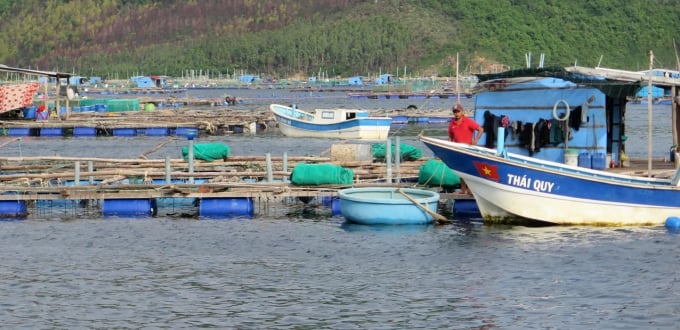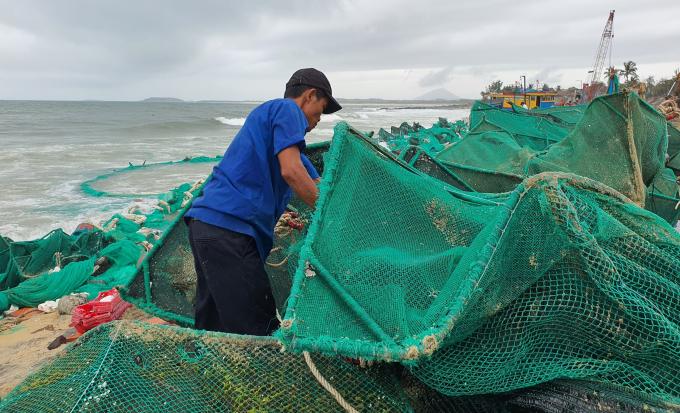November 27, 2025 | 02:18 GMT +7
November 27, 2025 | 02:18 GMT +7
Hotline: 0913.378.918
November 27, 2025 | 02:18 GMT +7
Hotline: 0913.378.918
According to the Phu Yen Province’s Department of Agriculture and Rural Development, in its master plan for fisheries development to 2025, the area for cage aquaculture is about 1,000 hectares in lagoons and bays in Song Cau town and 650 ha in open sea areas in Tuy An District.

Wooden cages in Phu Yen Province have not yet adapted to climate change and are prone to damage during the landfall of storms or strong winds. Photo: KS.
According to the plan, the province expects to have 49,000 cages, of which 32,900 cages are in Song Cau Town, 16,100 cages in Tuy An district and 208 ha of seaweed, 170 ha of snails and 150 ha of blood cockles.
In 2021, the total number of cages for aquaculture in the province was about 96,110 cages including more than 63,180 cages of meat lobsters, about 29,635 cages of nursing lobsters and more than 3,150 cages of sea fish.
At a conference to discuss solutions to develop marine aquaculture to adapt to climate change and prevent natural disasters organised by the Directorate of Fisheries and Phu Yen Province’s Department of Agriculture and Rural Development, Nguyen Tri Phuong, Deputy Director of the department said that the local infrastructure for cage aquaculture was simple, the cages poorly deallt with strong storms and winds, so they could only be raised in lagoons and bays.

The Directorate of Fisheries and the Phu Yen Province’s Department of Agriculture and Rural Development discuss solutions to develop marine aquaculture to adapt to natural disasters. Photo: MH.
Meanwhile, the province is located in an area with a high frequency of storms and tropical depressions, so the development of offshore mariculture faced many obstacles. Most of the coastal land has been prioritised for tourism development, so the aquaculture area has also decreased significantly. Most of the farming areas are located in low- and mid-tidal areas of lagoons and bays belonging to national landscapes, so it is difficult to convert to high-tech farming.

Unusual rain at the end of last month caused damages to many aquaculture cages in Phu Yen. Photo: MH.
For the formulation and implementation of policies for offshore mariculture, it’s difficult for the province to convert farming areas from lagoons and bays to open seas due to the large capital requirements.
Small establishments have not yet accessed advanced marine farming technology. The rate of using industrial feed in marine fish farming is not high due to inefficiencies. The consumption market is not available or stable, the investment capital is large, the risk is high, so they do not dare to invest, Phuong said.
He also said that the unstable seed source and the shortage of vocational training made the province difficult to meet the requirements of the industrial marine farming.
Assoc. Dr. Vo Van Nha, Deputy Director of the Research Institute for Aquaculture III also said that aquaculture development in Phu Yen still had shortcomings such as outdated technology, overloaded farming areas, environmental pollution, and diseases on farmed aquatic products.
The provomce was often hit by natural disasters, rain and storms while fisherman's cages were not secure and often suffered damage.
To overcome these shortcomings, the province needs to set up a working group to survey and evaluate in detail whether each farming area was suitable for planning, equipment and cages were suitable for natural conditions.

Farmers need to convert cages with new HDPE material to adapt to natural disasters and reduce the risk of damage in aquaculture. Photo: KS.
In addition, the province needs to develop a project to develop aquaculture in line with reality. In this project, it is necessary to build logistics service zones and form linkages for aquaculture. Along with investing in cages with new materials that are more expensive but more durable, and especially resistant to big waves and high winds.
Tran Dinh Luan, Director of the General Department of Fisheries, suggested that Phu Yen needed to choose appropriate solutions to develop marine aquaculture to adapt to climate change, prevent natural disasters, and solve other problems.
Farmers should invest in a system of cages, rafts and equipment using new HDPE materials. The Directorate of Fisheries will continue to accompany localities, as well as support fishermen to find solutions to develop more sustainable marine aquaculture.
The official Tran Dinh Luan said that directorate of fisheries was building and replicating the value chain production model for lobsters and planne d to implement in Phu Yen to increase added values and sustainability of the aquacultural industry.
Therefore, the province should encourage the development of various forms of association, especially the role of enterprises,cooperatives and cooperative groups, and create conditions for stakeholders to enjoy incentives like investment capital, land, and credit.
The province also aims to register the lobster brand in the domestic and export markets, as well as implement the registration, management and traceability of goods in accordance with official export requirements.
Translated by Hien Anh

(VAN) Tay Ninh’s livestock sector is undergoing a major transformation, applying high-tech, closed-loop circular models to build sustainable value chains.
/2025/11/26/3627-4-082628_818.jpg)
(VAN) From a small café on the red basalt highlands, Le Van Hoang started a business with clean coffee, building Enjoi Coffee into a symbol of organic agriculture in the Lam Dong plateau.
/2025/11/25/0045-1-135246_13.jpg)
(VAN) Ca Mau is researching a model of sea-encroaching embankments combined with viaducts and logistics service zones, aiming both to prevent erosion and create land funds for marine economic development.

(VAN) The information was shared at the seminar 'Urban Agriculture - Solutions for Developing Green Spaces,' organized by the Kinh te & Do thi Newspaper and the Biotechnology Center of Ho Chi Minh City.
/2025/11/19/4141-2-132831_216.jpg)
(VAN) One of Japfa's outstanding solutions is implementing digital transformation and artificial intelligence (AI) to optimize operations, enhance productivity, and advance sustainable development.
/2025/11/19/4847-1-093540_448.jpg)
(VAN) The Gia Lai Provincial People’s Committee had a working session with the delegation of the U.S. Department of Agriculture, the State of Idaho, and representatives of the State's leading enterprises.

(VAN) Ca Mau has a sufficient foundation to become a strong regional aquaculture center, where production integrates the economy, the environment, and the lives of the people.